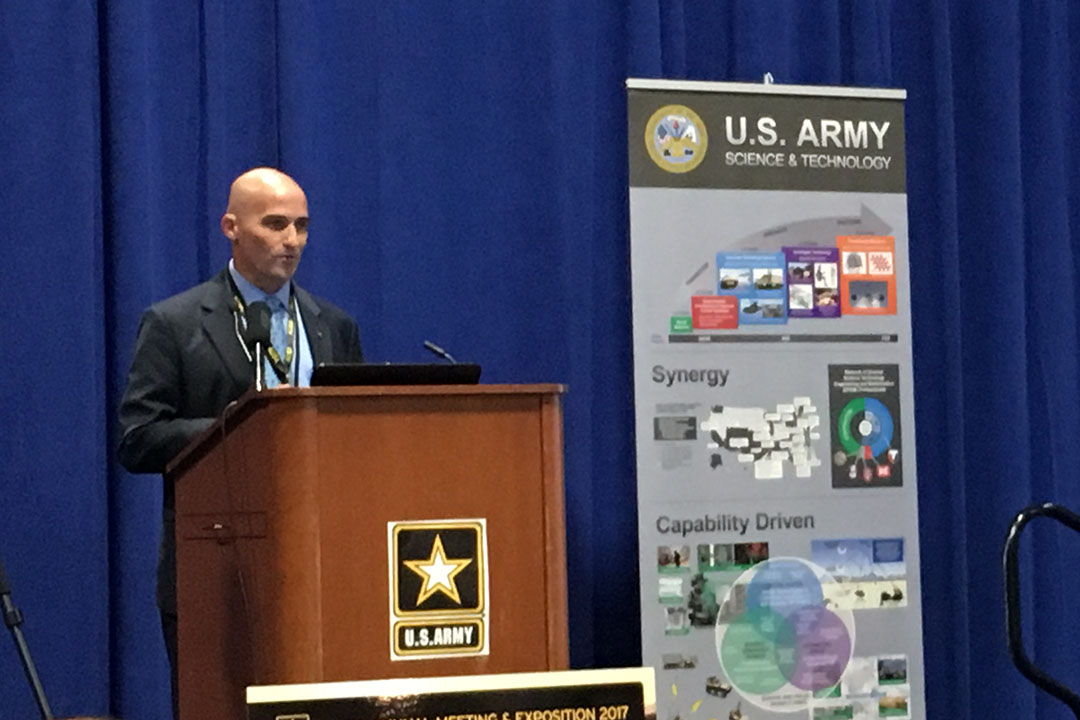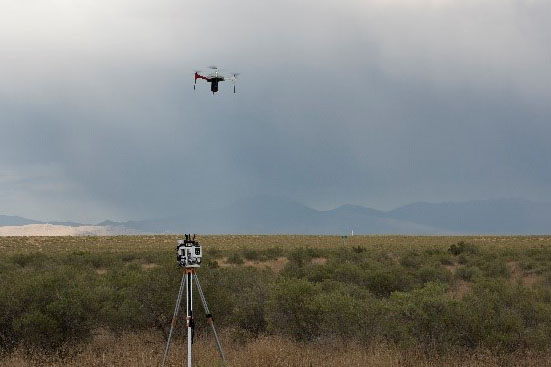// NEWS RELEASE
ECBC’s Layered Sensing Initiative Featured at 2017 AUSA Expo
CCDC Chemical Biological Center Public Affairs | October 19th, 2017
ECBC’s Layered Sensing Initiative Featured at 2017 AUSA Expo
DEVCOM CBC Public AffairsOctober 19th, 2017

Alan Samuels, Ph.D., explains ECBC’s innovative Layered Sensing Initiative at the annual Association of the U.S. Army Meeting and Exposition held at the Washington Convention Center in Washington D.C. on Oct. 11.
The U.S. Army Edgewood Chemical Biological Center’s Layered Sensing Initiative was among several U.S. Army Research, Development and Engineering Command (RDECOM) projects showcased at the annual Association of the U.S. Army (AUSA) Annual Meeting and Exposition held at the Washington Convention Center in Washington D.C.
The AUSA Annual Meeting and Expo is the nation’s biggest stage for Army organizations to showcase their best defense technology. The Edgewood Chemical Biological Center (ECBC) team behind the Layered Sensing Initiative presented the project at a special AUSA forum called Innovators’ Corner Oct. 11.
“The Layered Sensing Initiative we have under development combines ECBC’s chemical biological sensor technology with traditional force protection surveillance technology plus meteorological sensors,” ECBC team leader for the project, Alan Samuels, Ph.D., told an audience of expo attendees. “What makes it truly unique, however, is that through new developments in software and algorithms, we integrate all that data into a 3D picture of the threat. The result is that when a force is under a chemical or biological agent attack, we turn situational awareness into situational understanding.”
A nearby array of computer screens displayed images of an attack — the agent released forming red strands, which represent suspected clouds of gas or aerosol particles. Data projected onto the screen is generated by combining signals from a laser sensor system known as Light Detection and Ranging (LIDAR) — which localizes the source of the cloud — with dedicated chemical and biological agent detectors, meteorological sensors, ground surveillance radar and visible/infrared camera data. These data sources are all interconnected using the Integrated Sensor Architecture, developed for the Army by ECBC’s sister RDECOM laboratory Communications Electronics Research Development and Engineering Center (CERDEC) Night Vision and Electronic Sensors Directorate (NVESD). Sophisticated sensor data analytics compute the direction and speed of the cloud and plot it on the map for the battlefield commander and chain of command to see on their screens. The system also integrates with the Army Common Operating Environment, so the data can be shared across the U.S. Army.
Once the presence of a cloud is confirmed, the Layered Sensing Initiative’s quad copter, known as Deep Purple, carrying an array of chemical biological sensors, can fly out to it and gather data on its contents. That data is then sent to the software system in real time for analysis. “The result is actionable intelligence, constantly updated by new data streaming in from all the different kinds of sensors networked into the system. The commander can use it as it comes in to make split-second decisions on how to best protect the force under threat,” said Samuels.
The system solves another more mundane but widespread problem, false alarms. Chemical and biological sensors operating individually often sound false alarms when detecting fumes from industrial products such as petroleum and even cleaning solutions. By networking these sensors, an alarm from one can be correlated with the response from nearby alarms plus meteorological data to assign the alarm a confidence level using advanced logic algorithms. The system operators can then determine if it’s a false positive or if further surveillance using a mobile sensor is called for.
Yet another capability of the system is to get up to a six-minute jump on early warning over the non-networked chemical biological systems currently in use. If a number of sensors in the same vicinity all detect a possible agent at levels too low to trigger an alarm, the networked approach looks at it from another angle. The software analytics can use data aggregated from the sensors plus meteorological data to heighten the confidence level and initiate the alarm by itself. Those six minutes can be vital in ensuring that personnel in the path of the plume are fully protected.
The Layered Sensing Initiative is currently an advanced technology demonstration project funded by the Defense Threat Reduction Agency Joint Science and Technology Office. The next step for the initiative is to transition technology to an enhanced capability demonstration funded by the Joint Program Executive Office for Chemical and Biological Defense and tested using the ultimate end users, chemical biological specialists who operate in the field protecting U.S. Army brigade combat teams. Samuels and his team are also working with the U.S. Marine Corps to develop a multiservice data exchange environment.
The U.S. Army Combat Capabilities Development Command (DEVCOM) leads in the discovery, development and delivery of technology-based capabilities to enable Soldiers to win our nation’s wars and come home safely. DEVCOM is a major subordinate command of the U.S. Army Futures Command. The DEVCOM Chemical Biological Center is the Army’s principal research and development center for chemical and biological defense technology, engineering and field operations. The DEVCOM Chemical Biological Center is headquartered at Aberdeen Proving Ground, Maryland.

